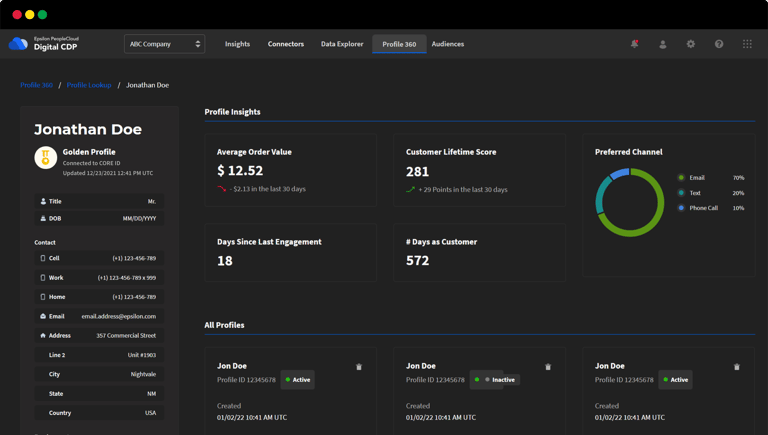
Olá, commerce aficionados. This is Hana Yoo, covering for senior editor and all-around commerce expert James Hercher while he’s on paternity leave. This week we’re diving into how El Corte Inglés is using Kevel’s CDP.
As Europe’s largest department store group, El Corte Inglés boasts a wide range of products.
The retailer’s hundreds of Portuguese and international brands include groceries, toys, baby goods, home appliances and decorations, technology and gourmet and luxury products.
Having so many product offerings is a unique selling point and a competitive advantage. But it can also make targeting more difficult, especially in light of privacy restrictions and ongoing signal loss.
“We needed a good CDP platform to focus on first-party data,” said Judit Takács Miranda, head of digital marketing at the Portuguese branch of El Corte Inglés.
Around nine months ago, El Corte Inglés partnered with Kevel, an API infrastructure platform that got into the customer data platform business earlier this year with the launch of a retailer-focused CDP.
Add to cart
Physical retailers with a large online presence need a way to organize and activate their first-party data.
In 2022, Kevel acquired CDP Velocidi to work with ecommerce companies that don’t have their own ad platforms, said James Avery, founder and CEO of Kevel. Despite the trend, not every retailer is going to build its own retail media network.
Kevel spent roughly six months tweaking Velocidi’s technology before rebranding it as Kevel Audience. El Corte Inglés used the product during its alpha phase.
The segmentation department
One of the main things El Corte Inglés wanted to do was segment its audiences by characteristics such as category, brand or time of purchase. A customer who buys in the fashion category, for example, might have a different profile and interests than someone looking for baby or technology products.
“Our clients are collecting that first-party data,” Avery said, “but then using custom event prediction to be able to say this is the group of people I should target for this message.”
That type of audience segmentation is “not possible with just the Facebook or the Meta pixel,” Takács Miranda said.
Although Google and Meta both have options to use first-party data, “it’s like direct upload,” she said, which doesn’t pass muster with the El Corte Inglés legal team.
El Corte Inglés is now using Kevel to ship audience segments for use across Meta, Google and Pinterest.
The power of prediction
But El Corte Inglés is seeing particular value from targeting people based on their likelihood to convert.
Using Kevel’s machine learning capabilities, El Corte Inglés can identify and target users who are more likely to buy products in specific categories in the near future.
Instead of segmenting campaigns in a more general way, like grouping customers together who bought something in the last year or visited the website in the past 30 days, El Corte Inglés can finesse segments to fit specific campaign needs.
For instance, if it’s running a technology promotion, El Corte Inglés can send the promo to users who are likely to make a tech purchase by looking at multiple factors, including web and app activity, in-store purchases and internal CRM data.
 Kevel’s predictive model also considers the frequency of purchase for different verticals. People buy groceries every week or two, but they make far fewer and less frequent purchases in categories like fashion or technology.
Kevel’s predictive model also considers the frequency of purchase for different verticals. People buy groceries every week or two, but they make far fewer and less frequent purchases in categories like fashion or technology.
By identifying potential buyers who are on the cusp of converting, the department chain can run more effective marketing campaigns, Takács Miranda said. As a result, “we’re spending less on remarketing audiences,” she said, which allows the company to focus more on new customer acquisition and customer retention.
For instance, if El Corte Inglés is running a campaign to promote toys, even during popular toy-buying occasions, such as Christmas, Easter or International Children’s Day, segmentation comes in handy to target specific users with relevant offers, such as parents and grandparents, aunts and uncles or people who might be buying toys for a friend’s child.
The department store’s conversion rate was three times better with Kevel than when using other remarketing segments, including from Meta, Takács Miranda said.
Omni state of mind
Kevel’s CDP also allows El Corte Inglés to integrate offline data with online data to get a more complete picture of customer purchase habits.
Although offline still makes up the bulk of the company’s business, Takács Miranda said, omnichannel clients have a higher value than purely online or offline clients.
By centralizing offline and online data, El Corte Inglés can also monitor spending trends, such as shifts from online to offline shopping or vice versa. For example, many customers shop online during their commutes, especially in supermarkets, and people are migrating back to the stores following the pandemic.
Takács Miranda acknowledges, though, that audience creation can be challenging in less populous markets, like Portugal, which has a population of just over 10 million.
Although Takács Miranda can home in on niche audiences, she’ll always be working with a small sample size. “We never get much data for a specific category,” she said.
Still, “segmentation is the base of digital marketing,” Takács Miranda said. “You can have the best designers, the best copywriters – but if you have the wrong audience segments, it won’t work.”






 By
By 



